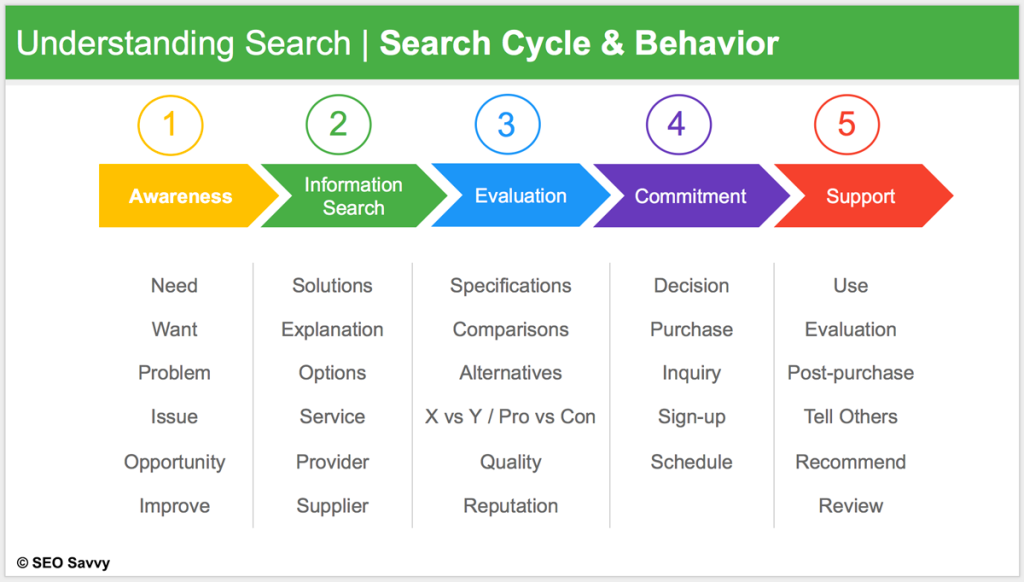
September 24, 2015
Guide to Consumer Decision Journey and the Search Cycle
Post #4 of our 4-part series on Audience Targeting
With more customer data available to marketers than ever before, the real question is how to utilize the information for more effective marketing. Audience targeting, the process of using market segmentation and personas to understand and empathize with your customers in order to construct customized campaigns, is one excellent use of this data. In previous blog posts, we showed you how to segment your audience and how to create personas. Now we’ll share how to use personas to target your audience with personalized content.
Map Personas to Consumer Decision Journey
Customers typically take a series of actions before converting to a sale. Using our gym example from the previous blog posts, the first step that our persona, Social Sara, may have taken when she decided to join a gym may have been to search online for fitness facilities in her area and check if they had classes. She may have considered several other factors before selecting a gym (Is the location close to home or work? What available class times? What’s the price? What size is the class? Who is the instructor/trainer?).
In marketing, the path to conversion is known as the consumer decision journey. While the consumer decision journey is often marked by the influence of traditional advertising and in-store interactions, since we’re a digital marketing agency, we’re only going to focus on the target audience’s online experience. When a person uses online search to find a product or service, they typically go through stages to find what they are looking for. Let’s take a look at the consumer decision journey and search cycle to see how your business might be able to approach each stage when marketing online. It’s important to note that a person will spend more or less time in these stages based on the price of the product or even the complexity of the service. So they may go through these stages quickly if the product is inexpensive or an impulse purchase. Whereas an expensive purchase or complex service will warrant more time to arrive at a purchase decision.

Consumer Decision Journey and the Search Cycle
- Awareness: Is your website and content optimized with the keywords your persona is using to search for the products or services you offer? For example, some keyword research might reveal that Social Sara is entering “fitness classes LA” into Google or Bing.
- Information Search: Customers are often faced with more than one option. Do you have pages and blog posts on your website to answer their questions, provide solutions and explain the options that ultimately persuade them you’re offering what they need or want?
- Evaluation: As customers move closer to making the purchase decision they will evaluate details and make comparisons. They will include comparisons on price, quality, specifications, pro vs. con and even reputation.
- Commitment: When your customer is ready to commit, making the purchase should be the easiest part. Your checkout or sign-up process should be user-friendly on both desktop and mobile devices and your contact information should be easy to find in case customers want to make in-store purchases or want to talk to a live person.
- Support: This phase is often overlooked since the customer has already purchased or converted. Supporting the customer as they use the product or service is vital to continued growth. How are you supporting and staying in contact your customers? Product use demonstrations for complex features, getting started guides and email newsletters tailored for use/engagement of your product or service is a great way to emphasize that your customers made the right decision and you are meeting their needs. Additional communication through social or email to keep them current on changes, new offerings, incentives, discounts, etc. can inspire brand loyalty. When customers are happy with your products and services they will advocate your brand through testimonials and reviews, which supports future customers in their decision journey and search cycle.
Audit Content and Make Improvements
Once you understand the journey your persona, or hypothetical customer, is taking to convert and remain loyal, you can audit your content to ensure you’re fulfilling his or her needs at each phase of the search cycle. You may find that you lack content or that your marketing message should be reframed. Perhaps you have a website, but it’s not optimized for the right keywords or you don’t address common customer questions. In the case of Social Sara, you could lose customers if you don’t have a page dedicated to fitness classes. You’ve done the work to empathize with your customers, and now it’s time to make sure you’re supporting them at all the stages of the consumer decision journey and search cycle.
Track Progress and Make Adjustments
As with any marketing strategy, it’s important to monitor the impact of recent changes to determine if they’re having the intended effect. Start by checking that Google Analytics is installed and tracking correctly. If analytics data is accurate and reveals that certain pages are performing poorly, then you may need to make adjustments. For instance, you may have created a page about fitness classes but failed to optimize other pages that should link to the fitness classes page, or maybe the user experience is poor and needs the use of images or video. Maybe users are having a hard time navigating to the classes page on mobile devices. There are numerous online resources to help you analyze website visitor traffic and troubleshoot the problem.
Beyond Keywords to Customers
For years, the focus of many digital marketers was primarily on which keywords had a high search volume and low competition. Not enough attention was paid to the people behind those keywords—on trying to understand their intent for entering those strings of words in search engines in the first place. Now business owners and marketers have access to a wealth of user data, and audience targeting can help them make sense of that data to better understand their customers and, ultimately, to establish a value-added link between their business objective and their customers’ needs.
Thanks for joining us in this 4-part series on Audience Targeting!



